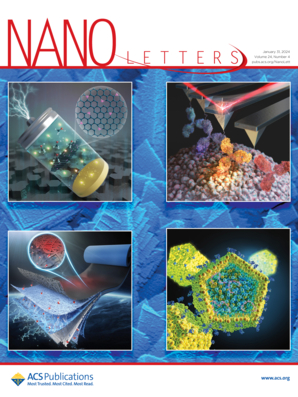Dislocation Multijunction-Driven Plasticity in HfNbTiZr High-Entropy Alloys
IF 9.6
1区 材料科学
Q1 CHEMISTRY, MULTIDISCIPLINARY
引用次数: 0
Abstract
Refractory high-entropy-alloys (HEAs) have emerged as promising structural materials for extreme environments, yet their practical application of body-centered-cubic (BCC)-HEAs is significantly hindered by the persistent deficiency in room-temperature ductility. Among various BCC-HEAs, the HfNbTiZr and its derivatives exhibit exceptional room-temperature tensile plasticity, though the mechanisms governing this behavior remain poorly understood. Through integrated experimental characterization and atomistic simulations, we reveal that the pronounced atomic size mismatch in HfNbTiZr generates substantial lattice distortions, which promote the formation of grid-like dislocation multijunctions. These unique features serve as effective nucleation sites for successive dislocation generation and enable massive dislocation multiplication─a remarkable phenomenon considering the inherent mobility limitations of both edge and screw dislocations in BCC-HEAs. Notably, the migration of these dislocation multijunctions generates abundant dislocation debris that functions as self-generated dynamic sources for mobile dislocations. This autocatalytic dislocation multiplication mechanism fundamentally underpins the intrinsic plasticity of HfNbTiZr across wide temperature ranges.

HfNbTiZr高熵合金的位错多结驱动塑性
难熔高熵合金(HEAs)作为一种极具应用前景的极端环境结构材料,其室温延展性的持续不足严重阻碍了其实际应用。在各种BCC-HEAs中,HfNbTiZr及其衍生物表现出优异的室温拉伸塑性,尽管控制这种行为的机制尚不清楚。通过综合实验表征和原子模拟,我们发现HfNbTiZr中明显的原子尺寸失配会产生大量的晶格畸变,从而促进网格状位错多结的形成。这些独特的特征是位错连续产生的有效成核位点,并使大量的位错增殖成为可能──考虑到BCC-HEAs中边缘位错和螺旋位错固有的迁移限制,这是一个显著的现象。值得注意的是,这些位错多连接点的迁移产生了大量的位错碎片,这些碎片是移动位错的自生动力源。这种自催化位错增殖机制从根本上巩固了HfNbTiZr在宽温度范围内的固有塑性。
本文章由计算机程序翻译,如有差异,请以英文原文为准。
求助全文
约1分钟内获得全文
求助全文
来源期刊

Nano Letters
工程技术-材料科学:综合
CiteScore
16.80
自引率
2.80%
发文量
1182
审稿时长
1.4 months
期刊介绍:
Nano Letters serves as a dynamic platform for promptly disseminating original results in fundamental, applied, and emerging research across all facets of nanoscience and nanotechnology. A pivotal criterion for inclusion within Nano Letters is the convergence of at least two different areas or disciplines, ensuring a rich interdisciplinary scope. The journal is dedicated to fostering exploration in diverse areas, including:
- Experimental and theoretical findings on physical, chemical, and biological phenomena at the nanoscale
- Synthesis, characterization, and processing of organic, inorganic, polymer, and hybrid nanomaterials through physical, chemical, and biological methodologies
- Modeling and simulation of synthetic, assembly, and interaction processes
- Realization of integrated nanostructures and nano-engineered devices exhibiting advanced performance
- Applications of nanoscale materials in living and environmental systems
Nano Letters is committed to advancing and showcasing groundbreaking research that intersects various domains, fostering innovation and collaboration in the ever-evolving field of nanoscience and nanotechnology.
 求助内容:
求助内容: 应助结果提醒方式:
应助结果提醒方式:


